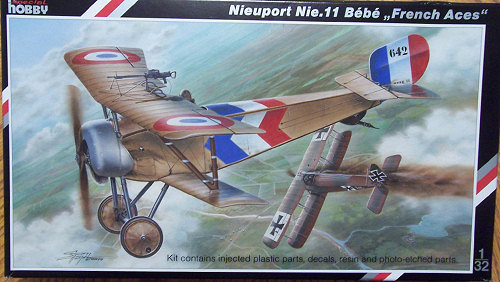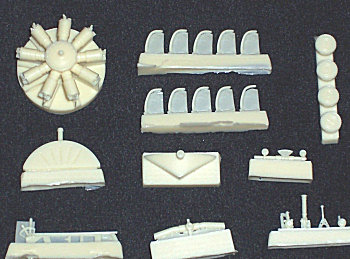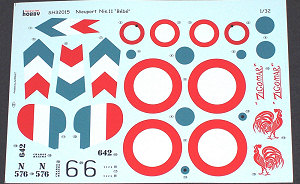
| KIT: | Special Hobby 1/32 Nieuport 11 'French Aces' |
| KIT #: | 43015 |
| PRICE: | $57.00 MSRP. $48.85 from www.earlshobbyhangar.com |
| DECALS: | Three options |
| REVIEWER: | Kyle Bodily |
| NOTES: |

| HISTORY |
In 1914 the Nieuport Company designed a new race plane for the Gordon-Bennet cup races. Sadly the First World War intervened and it, like so many early fighters became a tool of war in the defense of France. Quite interestingly the British were the first to order the new fighter called the Nieuport 10. The Nieuport 10 came in two basic types, single and double seaters. In 1915 Gustave Delage redesigned the N.10 and it became the Nieuport 11. The N.11 was smaller then the N.10 but since it used the same La Rhone 80 horsepower engine pilots noted its better performance and it quickly became known to the pilots that flew them as the Bebe (Baby). The aircraft was a true sesquiplane, this along with its very light over all weight imparted good maneuverability. For offensive armament the N.11 had a single Lewis machine-gun (or Belgium Rattlesnake as it was more commonly called in pilots slang) that fired over the propeller arc. The Nieuport 11 mounted other guns like the Hotchkiss machine gun, but as a rule of thumb it carried a Belgian Rattlesnake.
The Nieuport was found to be superior to the Fokker E types and soon showed that they were not Fokker fodder. In February 1916 the Germans felt that a thrust from the south would throw the French off balance and force them to pull troops from Flanders in the north to protect the almost mythically important town of Verdun in the south. Here the Germans believed that they could if not be totally successful in taking Verdun they would at least “Bleed France white”. The French tasked eleven squadrons or Escadrilles to protect the city and achieve air superiority. Even though the air battles were vicious, the French achieved air superiority and although towns like Fleury ceased to exist, Verdun never fell.
An interesting side note here is the fact that if you served long enough, all French soldiers and airmen served in the defense of this very important town.
The Nieuport 11 was upgraded to a Le Rhone 110 horsepower engine and was produced as the Nieuport 16. The Nieuport 16 served along side of the Nieuport 11 and eventually replaced them completely.
Along with France, Nieuport 11s were manufactured in Italy and Russia.
Operators of the Nieuport 11 were Belgium, Czechoslovakia, France, Italy, Netherlands, Romania, Russia, Serbia, Siam, Ukraine and the United Kingdom
It was also the first aircraft used by N.124, the Lafayette Escadrille when formed in April 1916.
| THE KIT |
 This looks
to be an excellent kit. The first thing that I noticed was the large set of
resin parts (24 resin parts to be exact) and the absolutely magnificent engine.
The engine detail is truly a work of art and could be displayed by itself. As
with the engine, all of the resin parts are very well cast and will need very
little work to remove them from their blocks.
This looks
to be an excellent kit. The first thing that I noticed was the large set of
resin parts (24 resin parts to be exact) and the absolutely magnificent engine.
The engine detail is truly a work of art and could be displayed by itself. As
with the engine, all of the resin parts are very well cast and will need very
little work to remove them from their blocks.  I see no flaws or air bubbles in
any of my parts; in fact I’ve never seen flaws or air bubbles in any Special
Hobby resin parts. This is good since some of the most detailed parts are in
resin.
I see no flaws or air bubbles in
any of my parts; in fact I’ve never seen flaws or air bubbles in any Special
Hobby resin parts. This is good since some of the most detailed parts are in
resin.
The plastic parts are on three trees and they look marvelous. You get 75 plastic parts and some are for what looks like an up coming release of a Nieuport 16, including Fusees LaPrieur or LaPrieur rockets. I hope that they release a 1/32nd scale Nieuport 16 soon.
All the plastic parts seem to be well molded with only a little flash around the mold gates but this will clean up quick. Oh yes, and all of the control surfaces are separate with very nice hinge detail. Over all the parts match well with my references, with very nice detail.
Additionally they also include a piece of film for the windscreen and a fret of photo etched parts with 50 individual detail parts including turnbuckles and engine push rods.
So that makes some 149 parts of plastic, photo-etched and resin. Oh ya! The more parts the more detailed the model.
 The decals
are some of the best I’ve seen. The colors look correct and you get enough to
build three different machines. First is Lt Pierre Dufaur de Gavardie of Esc.
N.12, 1916. Next is Lt Paul Tarascon of Esc N.62, 1916 and lastly is Lt Jean
M.D. Navarre of Esc. N67, 1915-1916. As with all decals from Special Hobby they
are spot on and from past experience they will go on perfectly.
The decals
are some of the best I’ve seen. The colors look correct and you get enough to
build three different machines. First is Lt Pierre Dufaur de Gavardie of Esc.
N.12, 1916. Next is Lt Paul Tarascon of Esc N.62, 1916 and lastly is Lt Jean
M.D. Navarre of Esc. N67, 1915-1916. As with all decals from Special Hobby they
are spot on and from past experience they will go on perfectly.
The instructions are very nicely done with beautiful full color four-view drawings for painting and decal placement. They include a rigging diagram and seem to be rather complete.
I am very
happy with the way this kit looks and am going to start this thing right away
| CONCLUSIONS |
This is just another example of Special Hobby’s kit crafting prowess. I am
quite a fan of their work and really place a premium on their kits. In short,
and in my opinion, they are second only to Eduard kits in quality. They make
only two WWI kits in 1/32nd (the Morane-Saulnier type.N and this kit)
but they are both excellent. Special Hobby has announced that they plan to
release an Albatros D.III. All I can say to that is please hurry, if these kits
are any indicator of what it will look like, Special Hobby will become the gold
standard for World War One kits in this scale.
That being said, this would probably not be a good first WWI model. However it looks like it will be less fiddley then some newer World War One kits. This kit looks to be a fun build. But as they say the proof is in the pudding and I have seen many of the newer kits that look BEAUTIFUL in the box but turn in to a quite difficult build. If you have a little experience with photo-etched and resin parts, and have a fondness for these Canvas Falcons, give it a shot. You’ll stretch your skills and build a very important WWI aircraft.
I give this kit very high marks and recommend it. Also keep in mind at $48.85, with photo-etched and resin parts included in the kit it is surly the best all around bargain for a 1/32nd scale First World War kit on the market.
Now, all I have to do is build it and see if it builds as good as it looks in the box.
| REFERENCES |
“French Aircraft of the First World War” by Dr. James Davilla and Arthur M. Soltan, Flying Machines Press
“Nieuport Fighters in action” aircraft #167 Squadron/signal publications
“Nieuport Aces of World War 1” by Norman Franks and Harry Dempsey, Osprey Publishing
Thanks to Earls Hobby Hanger for this kit. www.earlshobbyhangar.com
August 2007
If you would like your product reviewed fairly and quickly by a site that has near 400,000 visitors a month, please contact me or see other details in the Note to Contributors.